The intervertebral disc is the soft tissue located between the vertebrae of the spine. The disc acts as an effective shock absorber allowing an incredible range of motion of the 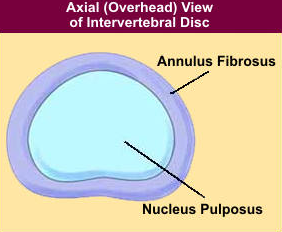 spine. There are two anatomical parts to the intervertebral disc, and the best analogy is a jelly doughnut. The inner part which would be the jelly is called the nucleus pulposis. The stiffer, outer component is called the annulus fibrosis.
spine. There are two anatomical parts to the intervertebral disc, and the best analogy is a jelly doughnut. The inner part which would be the jelly is called the nucleus pulposis. The stiffer, outer component is called the annulus fibrosis.
As a person ages, degeneration of the disc can occur with a tear developing in the outer annulus. This may allow the nucleus, which is the jelly, to squeeze out and become a herniated disc.
What is a bulging disc?
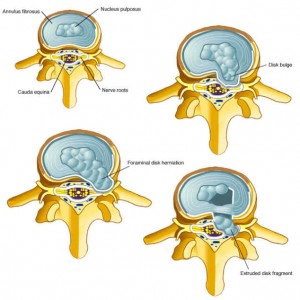
Top left is a normal disc. Top right is a disc bulge. Bottom left is a disc herniation and bottom right is when the herniation breaks off and is called an extrusion.
As a person ages, the intervertebral disc starts to lose some of its water. Normally, 80% of the intervertebral disc is made up of water. As degeneration occurs, this number decreases and the best analogy is that of a tire that is starting to flatten. When a tire starts to flatten, it bulges out, and that is analogous to what happens with a degenerating disc that turns into a bulging disc.
Is a herniated or bulging disc always painful?
The answer to this is no. Most individuals with bulging discs have no pain whatsoever. A study done back in 1990 by Boden et al. looked at asymptomatic individuals who received MRIs of their backs. over 40% of those individuals over the age of 40 had evidence of disc degeneration but no pain. If there are some tears in the outer part of the disc where there are nerve endings, an individual may have significant back pain from a bulging disc. This happens from time to time.
With regards to a herniated disc, it is not always painful either. If the disc material that squeezed out pinches a nearby nerve root (i.e. pinched nerve), it can spark up inflammation and become what is known as sciatica. This is pain that shoots down a person’s leg and feels like a burning, electrical sensation.
If the disc herniation does not push on a nearby nerve root, the person may have no pain at all, or may experience some back pain as a result of the torn disc simply irritating some nerve endings.
At any one point in time, one percent of the population suffers from sciatica. The numbers for back pain are much higher, and what percentage of that comes from symptomatic bulging discs has not been singled out. Together though, there are millions of Americans suffering from sciatica or back pain due to a symptomatic bulging disc at any one point in time.
How are these problems diagnosed?
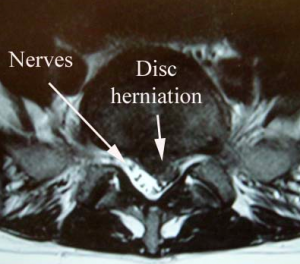
Large disc herniation seen on MRI pushing back into the spinal canal.
If the problem exists with no symptoms, it may not be diagnosed at all. If sciatica ispresent, the best study to see the herniated disc is an MRI. History and physical exam are usually very effective as well at shedding light on the problem.
With regard to the bulging disc, if a person is having chronic back pain then x-rays and an MRI can help show the disc degeneration. With chronic back pain that is not being helped with conservative treatments, a discogram may be necessary to identify a bulging, degenerated disc as the true source of the patient’s pain.
Call (602) 507 – 6550 to schedule your Appointment TODAY!

What treatments are available for symptomatic herniated discs and bulging discs?
Nonoperative treatments for the management of pain due to a herniated disc or bulging disc are usually very effective. Initial treatment for mild to moderate pain should consist of over-the-counter anti-inflammatories and Tylenol. For pain that is acutely exacerbated, short term narcotics prescribed by a pain doctor may be indicated. Narcotics on a chronic basis are not a good idea as the risks start to outweigh the benefits.
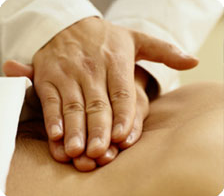
Along with these medications, muscle relaxers can help with acute back spasms, and neurologic modifying agents such as Lyrica and Neurontin may help with the pain of sciatica.
Physical rehabilitation and chiropractic treatment may work wonders including stretching, strengthening, range of motion exercises, heat and ice, electrical stimulation, ultrasound and massage therapy. Often times these are performed in conjunction with treatment from the AZ pain management doctor.
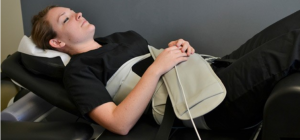
Spinal Decompression Therapy
Spinal decompression therapy is a revolutionary FDA cleared treatment that has gained immensely popularity over the last decade. It involves an intermittent traction placed through the low back which can help reduce symptoms from sciatica and symptomatic bulging discs. Pain relief is effective in over 85% of individuals and may last for months at a time.
A TENS unit may help decrease pain in the area and involves slight electrical impulses going through the skin. This can alter the way the brain perceives pain signals and be very effective, as the unit can be worn on the belt and be completely mobile as it runs on a simple battery.
Interventional treatments from a pain doctor can help tremendously and may include trigger point injections, facet injections, intradiscal injections, epidural steroid injections and possibly radiofrequency ablation. The effectiveness of these injections ranges from 70 to 90% depending on which study is reviewed. also, which procedure is indicated for an individual pertains to the symptoms being experienced and what the imaging studies show.
Therefore, the pain doctor will individualize necessary treatments.
How successful are the various treatments at achieving pain relief?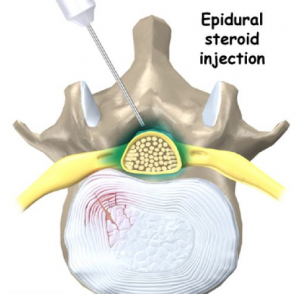
All in all, nonsurgical treatments are extremely effective in achieving excellent pain relief. For sciatica, the combination of options including chiropractic, physical rehabilitation, and epidural steroid injections are over 90% effective at achieving adequate pain relief and avoiding surgery.
When it comes to symptomatic bulging discs, over 80% of patients are able to come to a steady tolerable baseline amount of pain with the various treatments available.
How often is surgery necessary for herniated and bulging discs?
Less than 5% of those suffering from sciatica or bulging discs wind up going on to surgery. Unless either of these problems are causing neurologic deterioration or emergency bowel and bladder problems, surgery for the conditions is a completely elective decision. With the various nonoperative treatments available, well over 90% of individuals are able to achieve acceptable pain relief and avoid an operation.
If you are suffering from back pain or sciatica, Arizona Pain Specialists offers a full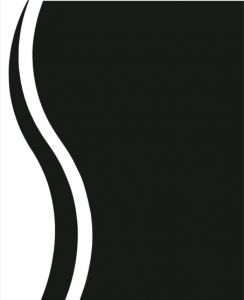 breadth of nonoperative treatments. This includes both traditional and alternative treatments including all of those mentioned in this article. Arizona Pain has an award-winning, board-certified team of pain management doctors in Arizona along with chiropractors at each of their Valleywide locations.
breadth of nonoperative treatments. This includes both traditional and alternative treatments including all of those mentioned in this article. Arizona Pain has an award-winning, board-certified team of pain management doctors in Arizona along with chiropractors at each of their Valleywide locations.
These locations serve Phoenix, Scottsdale, Glendale, Mesa, Chandler, Gilbert, Fountainhill’s, Cavecreek, surprise, Peoria, Goodyear, Tempe, Avondale and more.
Call (602) 507 – 6550 to schedule your Appointment TODAY!

![]()